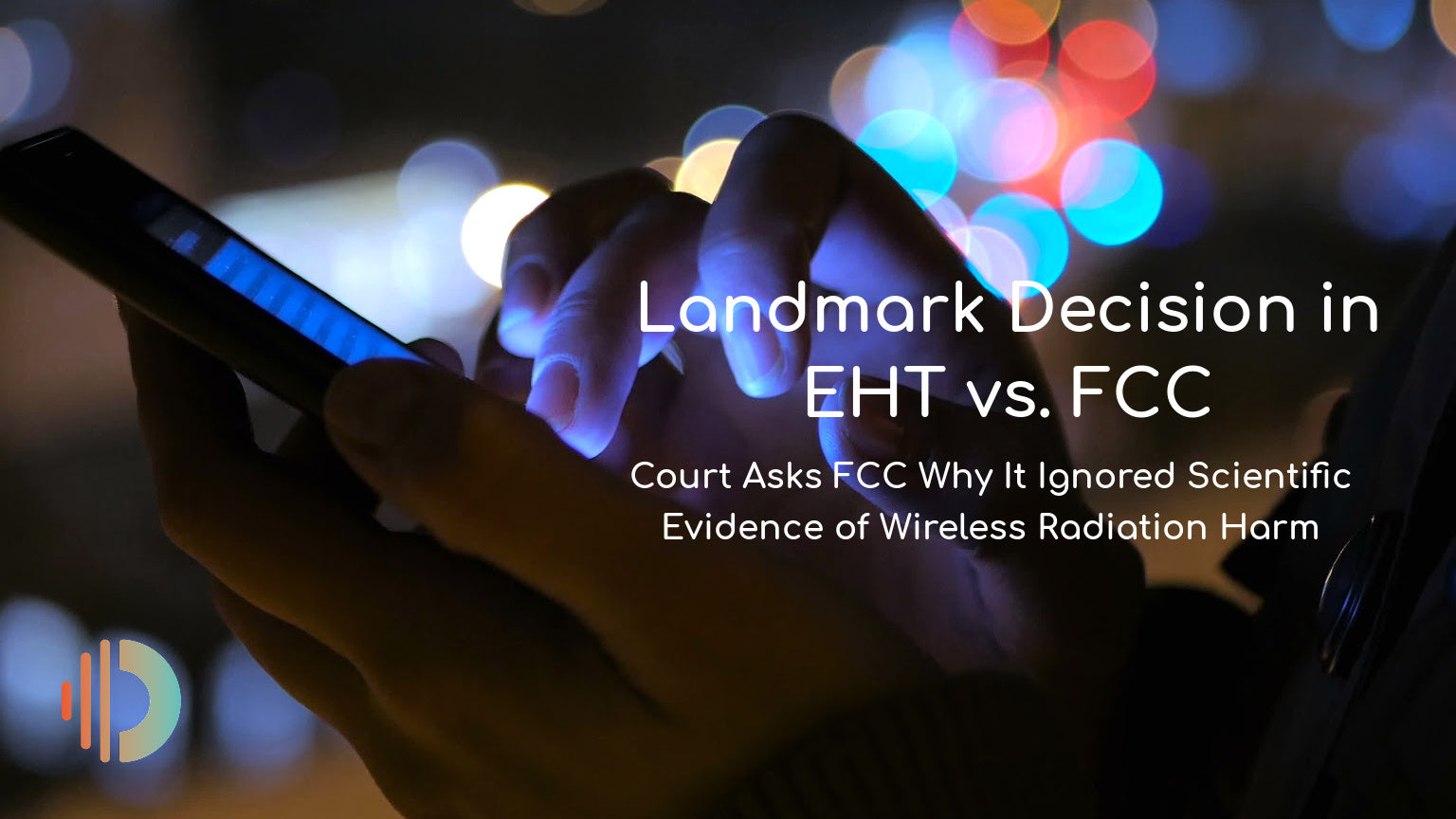
Would you be comfortable traveling in an aircraft that was built according to guidelines set 25 years ago? We’re guessing not.
So why should the case be any different when it comes to radiation safety limits for cellphones and wireless devices?
This is precisely the question posed by the Environmental Health Trust (EHT) in the petition they filed on July 30, 2020 against the Federal Communication Commission (FCC) in the US Court of Appeals for the District of Columbia. The case was to challenge the FCC’s refusal to update the wireless radiation safety guidelines that have been set as far back as 1996. And it makes special reference to how the FCC has ignored all the thousands of biological studies that show how adverse health effects, including cancer, can be caused by microwave radiation fields. The same fields that we are touching every day via our cellphones.
We have been closely watching this case as it has unfolded and today we’ve got a heartening new update for you!
As of August 2021, The U.S. Court of Appeals for the District of Columbia has ruled that the FCC has violated the Administrative Procedure Act by failing to respond to comments and scientific evidence submitted by scientists, doctors, and organizations that exposure to RF radiation at levels even below the FCC’s current safety limit can cause negative health effects not related to cancer.
Moreover, the court has ordered the FCC to re-evaluate their safety guidelines for wireless emissions. They also have to offer concrete explanations as to why they believe that emissions by cellphones and other wireless devices operating under the FCC guidelines do not pose risk to human health.
By finally giving a voice to the public in this crucial issue, this is a historic decision!
The Background
Do you remember what mobile phones looked like 25 years ago? Remember those tiny devices with even tinier screens? We used them for nothing more than important calls and urgent text messages (and the occasional Nokia Snake game if we were really bored). Our lives, for the most part, were not dependent on wireless devices.

Photo by Sumeet Singh on Unsplash
Cut to today - everything has changed! Most of our daily life has gone wireless. The typical digitally savvy adult of today is hooked to their smartphone, has a wireless watch strapped onto their wrist, and works on a laptop/ iPads - probably while listening to music on their wireless headphones.

Photo by SCREEN POST on Unsplash
Professor Olle Johansson calculated that today, we have 1 quintillion times more wireless radiation passing through our bodies than the background norm of the days before mobile phones and wireless internet. Take a moment to reflect on how much more exposed to wireless radiation we are today. In such a case, would it still make sense to stick to the safety guidelines for wireless radiation that were established as far back as 1996?
The sheer proliferation of wireless devices in our daily lives, constant use of wireless devices by children and adults (increase exponentially after Covid), together with the impending rollout of 5G technology implores a hard reassessment of the 25-year old exposure limits currently considered safe by the FCC. These now obsolete guidelines solely look at the health effects of thermal radiation (radiation effects caused by heat), with no consideration of the harm that comes from non-thermal levels of RFRs on human health.
Add to that the fact that there has been a growing body of published studies documenting the harmful health effects of non-ionizing radiation.
In light of the above facts, this ruling is a big step in the right direction toward the accountability that is needed to protect and inform the public of the potentially harmful effects of wireless radiation on human, animal, and environmental health.
What Did The Court Find?
Back in 2012, a report published by the Government Accountability Office suggested that the FCC re-evaluate its safety guidelines. After this, the FCC opened the docket 13-84 in 2013 and asked for public opinion. The response was overwhelming - with countless scientific organizations, scientists, doctors, and individuals sharing recorded evidence of the harmful health effects of wireless radiation.
Despite receiving the evidence, the court made the following observation in their ruling:
- The FCC’s decision in December 2019 to retain the 1996 safety limits for human exposure to wireless radiation was “arbitrary and capricious”.
- The FCC failed to respond to record evidence that exposure to RF radiation below the FCC’s current limits may cause negative health impacts unrelated to cancer.
- The FCC ignored and did not respond to over 200 comments on record by people who had undergone injury or illness because of electromagnetic radiation sickness.
- The FCC “demonstrated a complete failure to respond to comments concerning the environmental harm caused by RF radiation”.
The Directives Ordered by The Court to FCC
Keeping in mind their failure to adequately address the concerns submitted by the EHT and the general public, the court has asked the FCC to take the following actions:
- Provide an explanation of its decision to retain its testing procedures (which we have exposed as inadequate) to assess whether cellphones or other portable devices comply with its guidelines.
- Address the effect of RF radiation on children, the health implication of long-term RF radiation exposure, the ubiquity of wireless devices today, and other technological developments that have happened since the FCC last updated its safety guidelines.
- Address the impact of RF radiation on the environment.
Why Is This Ruling Important?
After years of appeals by the scientific community, it’s the first time that the dangerous health effects of wireless exposure are finally being officially recognized by the public office.
This is the first time that a judicial body has so clearly held a government body answerable on the matter of human health and wireless radiation exposure. Secondly, the court decision takes into account the growing scientific evidence on the harmful effects of wireless radiation.
Moreover, this ruling couldn’t have come at a more crucial time. The COVID-induced lockdown has increased our exposure to wireless devices manifold - both for children and adults. What's more, we stand on the verge of a multi-national 5G technology rollout, which has also been deemed 'safe' and compliant with the 1996 guidelines. 5G could expose us to up to 6 times higher ambient radiation than what we are currently exposed to. So if we follow Professor Johansson's calculations, that would make it 6 quintillion times more radiation passing through our bodies (that's 6,000,000,000,000,000,000 times) than the days before wireless technology.
The Way Ahead
Considering the potential risks that increased wireless radiation could pose to humans, animals, and the environment, this landmark ruling couldn’t have come at a better time! By holding the FCC accountable, we hope that this ruling will lead to the establishment of safer, scientifically sound, and accurate safety limits that will protect all living beings from the harmful effects of wireless radiation. We will keep following this crucial case and share important updates!
References and Interesting Reads:
More information about the Care from Law360




Share and get 15% off!
Simply share this product on one of the following social networks and you will unlock 15% off!